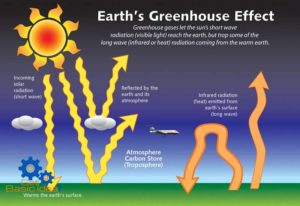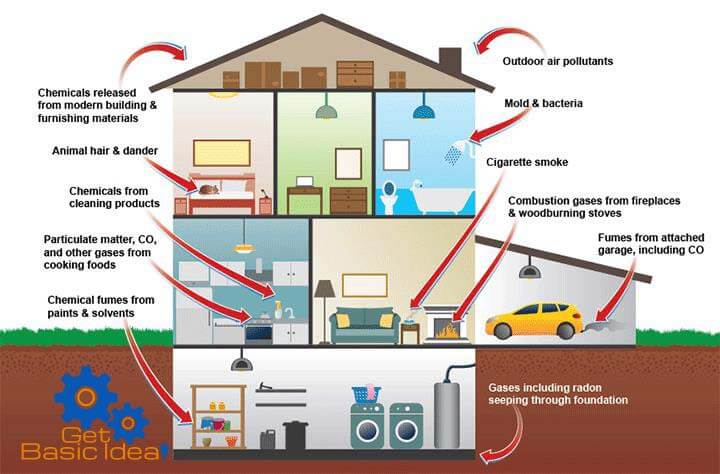Greenhouse Effect and Global Warming | Environmental Chemistry
Greenhouse Effect.
Greenhouse effect is a mechanism of maintaining the temperature of our earth. The earth heats up from the radiation received from the sun and the heat is reflected back into the atmosphere in the form of infra-red (IR) radiation. The earth receives a large amount of radiant energy from the sun and about 30% of this energy is reflected back to the atmosphere. The light energy gaining from the sun is used for photosynthesis process by the green plants and the evaporation of water from the oceans occurs due to the heat. Most of energy received from the sun is absorbed by soil, rocks and water and a part is reflected back to the atmosphere. The reflected heat is absorbed by water vapor and carbon dioxide thereby warming the earth. This process which is known as “green hose effect” occurs naturally and maintains the temperature of the earth making it suitable for life.
Greenhouse effect is the main reason for the temperature difference between the earth and the moon even though they are situated nearly at the same distance from the sun. The average temperature of the moon is around -15C0 while that of the earth is around 15C0. This is due to the presence of atmosphere on the earth comprising of gases such as oxygen, nitrogen, carbon dioxide and water vapor resulting the greenhouse effect. But the moon has no such an atmosphere.
Water vapor is mainly responsible for this effect and is not a serious environmental concern since the amount of water in the ecosystem is a constant. But the increasing levels of other greenhouse gases lead to increase in the world’s temperature. Mainly the anthropogenic activities result in increased levels of carbon dioxide (CO2), methane (CH4), ozone (O3), sulfur dioxide (SO2), chlorofluorocarbon (CFC) and nitrogen dioxide (NO2) which are collectively known as greenhouse gases causing the earth to grow warmer and warmer. The homo atomic molecules such as ozone and the hetero atomic molecules such as carbon dioxide, methane, nitrogen dioxide can act as greenhouse gases by absorbing radiation.
When the levels of greenhouse gases increased more than the naturally required amount the temperature of the earth is increased resulting the global warming.
Global Warming.
The natural or human induced increase in the average temperature of the atmosphere near the earth surface is known as the global warming. This is mainly due to human activities and can be a part of normal climatic change cycle. The temperature of earth is artificially increased beyond normal level due to increased emission of greenhouse gases with increased use of carbon resulting in increased particulate emissions. This effect can be identified as one of the worse outcome of the industrial revolution.
Carbon dioxide is the major contributor for the global warming, and the other gases such as NOx, CFC can also induce this effect. Even though the concentration of CFC in the atmosphere is low its contribution for temperature rising is high since its long lifetime and higher ability to absorb IR.
If the global warming process continues as present the earth will no longer be a better place for living beings. So it is important to consider reduce this effect by reducing the emission of greenhouse gases.
There are some sources which can act as sink for greenhouse gases. A sink is a place or a system with the ability to recapture these greenhouse gases and provide natural balance required to maintain steady state concentration. The green plants absorb carbon dioxide for the process of photosynthesis and fixes it in carbohydrates. So the adequate forest cover is really essential to overcome this problem. The oceans can also act as a natural sink for carbon dioxide since they have large capacity to absorb large capacities of CO2 due to presence of calcium carbonate in the form of coral. Living corals deposit insoluble calcium carbonate which is taken as the form of calcium bicarbonate after the death of coral.
Other greenhouse gases such as CH4 and NO2 are removed by photolysis through the reaction with hydroxyl free radicals acting as a sink.
Impacts of global warming.
- Increases sea level by melting polar ice caps and due to thermal expansion of water
- May bring violent storms such as cyclones and hurricanes
- Can lead to extinct some animal species such as polar bear, penguin
- Reduce biodiversity
- Can cause climatic changes
- Can cause behavioral changes of certain species
- Desertification
- Reducing the water levels of lakes and rivers
Admin of Get Basic Idea / Senior Solution Architect.




